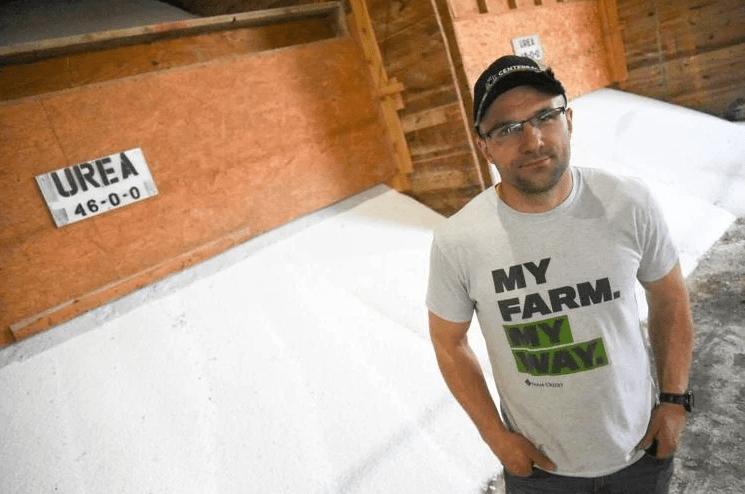WAR IN UKRAINE, OTHER GLOBAL FACTORS DRIVING UP COST OF FERTILIZER

Photo Credit: SHANNON ROAE, Meadville Tribune. James Tobin, Manager of Centerra Co-Op’s Cambridge Springs and Mill Village, PA locations is seeing a lot of fluctuation in the price of fertilizer.
By Sean P. Ray Meadville Tribune Mar 21, 2022
Major global events, including the Russian invasion of Ukraine, are driving up the cost of a relatively mundane but necessary resource for farmers: fertilizer.
“We haven’t seen anything as volatile as it has been this year,” said James Tobin, manager of the Cambridge Springs Centerra Co-op location. “Price fluctuations of $100 a time.”
Tobin listed the conflict in Ukraine as one of the factors driving up the price, mentioning that Russia is “one of the top three sources of fertilizer.” However, he said there were other events at play, ranging from cleanup operations done by China ahead of the Winter Olympics to rumors of a possible rail strike in Canada.
Still, the war is taking its toll on an already expensive necessity for farmers. Kelly Hyde, manager of Erie Crawford Co-op, said prices were already high last year, and while it looked like they were starting to go down again, the conflict has pushed those costs right back up and then some.
Hyde said he’d seen increases from $600 a ton last year, to $950 or $1,000 a ton this year.
Bill Zeiders, media communications director for Pennsylvania Farm Bureau, explained that Russia and neighboring Belarus, which is also involved in the conflict, are among the biggest exporters of the ingredients necessary to make artificial fertilizer. Sanctions resulting from the war targeting Russia have, as a result, driven up the cost of those ingredients.
“It’s not the farmers’ fault this is happening,” Zeiders said. “This is obviously a result of a lot of factors that are global in nature in a lot of cases.”
While many people might not think of it like that, fertilizer is a traded commodity, Hyde said. It has investors who try to buy it up and then sell when the price is higher. Global events can affect how much these investments are worth and whether they’re being sold or not.
Joe Paxton, of Irishtown Acres in Mercer County, is one farmer who has felt the pain of the high cost of fertilizer. Despite buying an order before the conflict began, he paid several times more for his nitrogen fertilizer.
“We’ve bought some of this year’s fertilizer at the end of last year,” Paxton said. “Comparing that to the year before, well, nitrogen is up almost 300 percent.”
Paxton has a herd of cattle at his farm, being primarily a dairy operation. As such, he’s able to use manure as a stand-in for fertilizer, but that only gets him enough to cover about one-fourth of the acreage he plants on.
As such, Paxton is aiming to be careful in how he utilizes his fertilizer supply this year.
“We’re certainly going to use it sparingly,” he said. “We’re not going to put anything in excess.”
Joey Atkins, field and forage crops educator at the Mercer County Penn State Extension, said most fertilizer production is done overseas, with some in Canada. While he’s sure there are domestic operations, he said ramping up such production to meet the demand would prove incredibly challenging.
Photo Credit: SHANNON ROAE, Meadville Tribune. Piles of nitrogen for fertilizer mixtures at Centerra Co-Op’s Cambridge Springs location.
Getting hands on fertilizer could also prove a challenge. Atkins said one co-op he speaks with already has all of its fertilizer stock spoken for, and the supplier the co-op purchases its supply from “won’t even quote them a price.”
Fertilizer is critical for farming. While garden growers might be able to get away without it, Atkins said to get the yield necessary to make a profit takes proper fertilization.
“The lion’s share of the yield is made in the nutrients that are there,” he said.
Atkins gave some suggestions on farmers looking to save where they can. He recommended farmers get their soils tested in order to optimize where fertilizer is most needed and where less can be applied.
“You might have a lot more fertility in the soil than you think, and there’s some guys who over-apply,” he said.
He also suggested farmers take a look at their pest pressure, and try to pare back where possible. He said some farmers spray fungicide on their crops no matter what, even if crops often aren’t affected anyways.
As to the long-term effects of the price increases, those involved in the agricultural industry can only speculate. While fertilizer is more expensive, Zeiders said prices for crops like grain, wheat, soybeans and corn are also high currently, and farmers could see profits to meet the higher expense.
On a more negative note, Hyde said he could foresee farmers having issues getting a line of credit from banks for up-front cost to get the planting season started. Hyde said farmers often need credit for buying things like bulk fertilizer, and the amount they ask for may be much higher with prices the way they are.
“They would have to go back to their creditors and say, ‘Hey, I need twice the money,’” Hyde said. “Well, what if their creditors don’t agree to that?”
Over at Centerra, Tobin said the co-op has had to be “a little more strategical” in the amount it pre-pays for fertilizer this year. The co-op is further trying to get as much fertilizer in stock as it can, ensuring there will be enough to meet potential later demand.
Whatever the outcome, however, the price increase, alongside other cost increases from inflation, is causing plenty of trouble now.
“It’s just going to be a tough year for everyone,” Paxton said. “Every aspect of food production right now is going to get more expensive.”
Sean P. Ray can be reached at (814) 724-6370 or by email at sray@meadvilletribune.com.
Read the article or subscribe to the Meadville Tribune HERE





